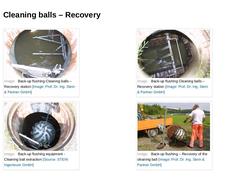
|
|
(Image: Back-up flushing Cleaning balls – Recovery station) |
(Image: Back-up flushing Cleaning balls – Recovery station) |
|
(Image: Back-up flushing Cleaning balls – Process description) |
(Image: Back-up flushing – Recovery of the cleaning ball) |
|
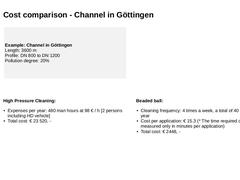
|
Example: Channel in Göttingen
Length: 3600 m
Profile: DN 800 to DN 1200
Pollution degree: 20% |
High Pressure Cleaning: - Expenses per year: 480 man hours at 98 € / h [2 persons including HD vehicle]
- Total cost: € 23 520, -
Beaded ball: - Cleaning frequency: 4 times a week, a total of 40 weeks per year
- Cost per application: € 15.3 (* The time required can be measured only in minutes per application)
- Total cost: € 2448, -
|
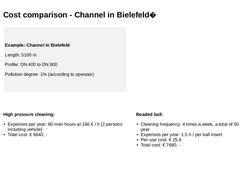
|
Example: Channel in Bielefeld Length: 5100 m Profile: DN 400 to DN 800 Pollution degree: 1% (according to operator) |
High pressure cleaning: - Expenses per year: 80 man hours at 166 € / h [2 persons including vehicle]
- Total cost: € 6640, -
Beaded ball: - Cleaning frequency: 4 times a week, a total of 50 weeks per year
- Expenses per year: 1.5 h / per ball insert
- Per-use cost: € 25.6
- Total cost: € 7680, -
|

|
|
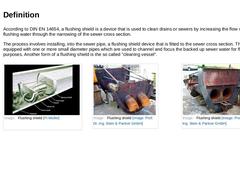
|
According to DIN EN 14654, a flushing shield is a device that is used to clean drains or sewers by increasing the flow velocity of the flushing water through the narrowing of the sewer cross section. The process involves installing, into the sewer pipe, a flushing shield device that is fitted to the sewer cross section. The shield is equipped with one or more small diameter pipes which are used to channel and focus the backed up sewer water for flushing … |
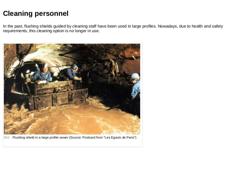
|
In the past, flushing shields guided by cleaning staff have been used in large profiles. Nowadays, due to health and safety requirements, this cleaning option is no longer in use. (Image: Flushing shield in a large profile sewer (Source: Postcard from "Les Egouts de Paris")) |
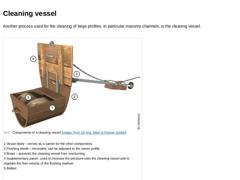
|
Another process used for the cleaning of large profiles, in particular masonry channels, is the cleaning vessel. (Image: Components of a cleaning vessel) |
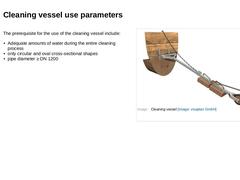
|
The prerequisite for the use of the cleaning vessel include: - Adequate amounts of water during the entire cleaning process
- only circular and oval cross-sectional shapes
- pipe diameter ≥ DN 1200
|
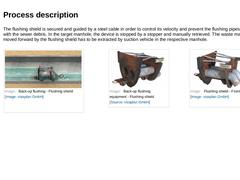
|
The flushing shield is secured and guided by a steel cable in order to control its velocity and prevent the flushing pipes from colliding with the sewer debris. In the target manhole, the device is stopped by a stopper and manually retrieved. The waste material that is moved forward by the flushing shield has to be extracted by suction vehicle in the respective manhole. | (Image: Back-up flushing - Flushing shield) | (Image: Back-up flushing equipment - … |
|
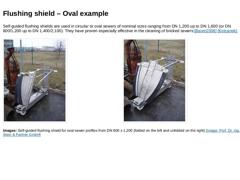
|
Self-guided flushing shields are used in circular or oval sewers of nominal sizes ranging from DN 1,200 up to DN 1,600 (or DN 800/1,200 up to DN 1,400/2,100). They have proven especially effective in the cleaning of bricked sewers [Baren2006] [Kotcanek]. (Image: Self-guided flushing shield for oval sewer profiles (folded position)) (Image: Self-guided flushing shield for oval sewer profiles (open position)) Images: Self-guided flushing shield for oval … |
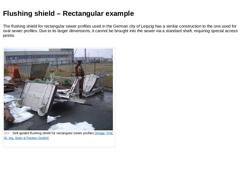
|
The flushing shield for rectangular sewer profiles used in the German city of Leipzig has a similar construction to the one used for oval sewer profiles. Due to its larger dimensions, it cannot be brought into the sewer via a standard shaft, requiring special access points. (Image: Self-guided flushing shield for rectangular sewer profiles) |
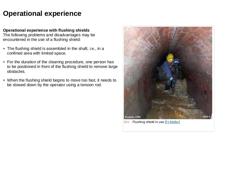
|
Operational experience with flushing shields
The following problems and disadvantages may be encountered in the use of a flushing shield: -
The flushing shield is assembled in the shaft, i.e., in a confined area with limited space.
-
For the duration of the cleaning procedure, one person has to be positioned in front of the flushing shield to remove large obstacles.
-
When the flushing shield begins to move too fast, it needs to be slowed down by the …
|
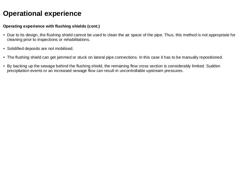
|
Operating experience with flushing shields (cont.) -
Due to its design, the flushing shield cannot be used to clean the air space of the pipe. Thus, this method is not appropriate for cleaning prior to inspections or rehabilitations.
-
Solidified deposits are not mobilised.
-
The flushing shield can get jammed or stuck on lateral pipe connections. In this case it has to be manually repositioned.
-
By backing up the sewage behind the flushing shield, the …
|

|
Operating experience with flushing shields (cont.) -
Generally, a team of 4-5 people is required for the assembly, operation and removal of the flushing shield. The cleaning performance per day strongly depends on the local limiting conditions. It varies between just a few metres in the case of low water levels and large deposit amounts to several hundred metres in the case of favourable water levels and small deposit amounts. The daily performance …
|
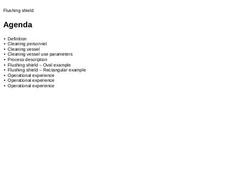
|
|

|
|

|
Congratulations! You have successfully finished this module. Next you will have the opportunity to review the newly acquired knowledge with an interactive questionnaire. You can of course still navigate back to any point in the modules if you wish to review a specific point or subject. Stay curious! |
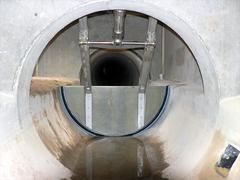
|
In addition to an introductory overview of the various flushing methods and the criteria that must be taken into account when selecting these measures. This module focuses thematically on the physical properties of shafts and the different designs of flushing methods. After completing this module, you will have a sound knowledge of: - process sequences in surge flushing;
- influences on the efficiency of bed-load and suspension waves;
- differentiation of surge flushing devices according to their constructive design or technical equipment;
- process sequences in back-up flushing and their application limits.
|
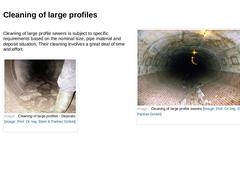
|
Cleaning of large profile sewers is subject to specific requirements based on the nominal size, pipe material and deposit situation. Their cleaning involves a great deal of time and effort. (Image: Cleaning of large profiles - Deposits) (Image: Cleaning of large profile sewers) |
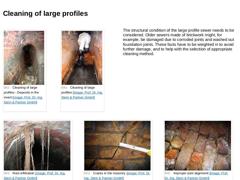
|
(Image: Cleaning of large profiles - Deposits in the invert) (Image: Cleaning of large profiles) The structural condition of the large profile sewer needs to be considered. Older sewers made of brickwork might, for example, be damaged due to corroded joints and washed out foundation joints. These facts have to be weighted in to avoid further damage, and to help with the selection of appropriate cleaning method. (Image: Root infiltration) |
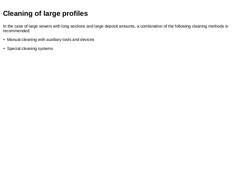
|
In the case of large sewers with long sections and large deposit amounts, a combination of the following cleaning methods is recommended: |
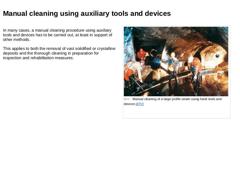
|
In many cases, a manual cleaning procedure using auxiliary tools and devices has to be carried out, at least in support of other methods. This applies to both the removal of vast solidified or crystalline deposits and the thorough cleaning in preparation for inspection and rehabilitation measures. (Image: Manual cleaning of a large profile sewer using hand tools and devices) |
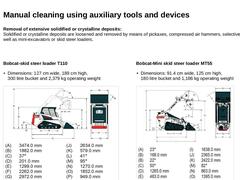
|
Removal of extensive solidified or crystalline deposits:
Solidified or crystalline deposits are loosened and removed by means of pickaxes, compressed air hammers, selective blasting as well as mini-excavators or skid steer loaders. Bobcat-skid steer loader T110 -
Dimensions: 127 cm wide, 189 cm high,
300 litre bucket and 2,379 kg operating weight
(Image: Bobcat-skid steer loader T110) Bobcat-Mini skid steer loader MT55 -
Dimensions: 91.4 cm wide, 125 …
|
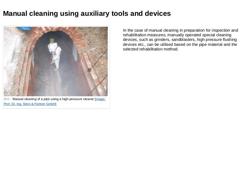
|
(Image: Manual cleaning of a pipe using a high-pressure cleaner) In the case of manual cleaning in preparation for inspection and rehabilitation measures, manually operated special cleaning devices, such as grinders, sandblasters, high pressure flushing devices etc., can be utilised based on the pipe material and the selected rehabilitation method. |
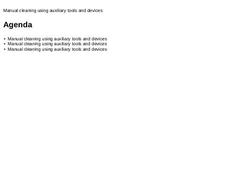
|
|